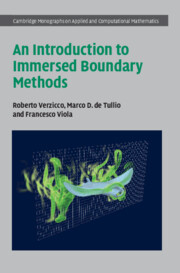
-
Select format
-
- Publisher:
- Cambridge University Press
- Publication date:
- 30 October 2025
- 06 November 2025
- ISBN:
- 9781009128438
- 9781009123204
- Dimensions:
- (229 x 152 mm)
- Weight & Pages:
- 0.498kg, 236 Pages
- Dimensions:
- Weight & Pages:
You may already have access via personal or institutional login
Book description
Unlock the potential of computational fluid dynamics with this essential guide for master's and graduate students, and researchers. It explores the immersed boundary method (IBM), a revolutionary approach for simulating flows in complex geometries. With a focus on fluid/structure interaction, it examines theoretical principles and practical implementations, offering insights into tackling intricate geometries and enhancing simulation accuracy. The book features a series of numerical examples that increase in complexity, and is accompanied by the source code, allowing readers to replicate results and deepen their understanding. Whether you're wanting to refine your skills or embark on new research, this introduction will empower you to master the art of complex flow simulations.
Reviews
‘A much-needed reference, this book offers a clear and self-contained overview of the immersed boundary method. Blending theory and practical examples, and via the illustrative accompanying code, it covers all key aspects of the approach, making it an invaluable resource for both experienced researchers and newcomers.’
Simone Camarri - University of Pisa
‘Immersed boundary methods have become an indispensable tool for modern numerical simulations in fluid dynamics and way beyond, and the number of publications employing them is still exploding. Yet there has been no systematic textbook on immersed boundary methods. The wonderful and deeply thought-through textbook by Verzicco et al. now fills this gap. It is immediately indispensable both for researchers already employing the methods and for novices who want to learn them.’
Detlef Lohse - University of Twente
Contents
-
1 - Introduction
pp 1-15 -
-
- You have access
- Export citation
-
Metrics
Altmetric attention score
Full text views
Full text views help Loading metrics...
Loading metrics...
* Views captured on Cambridge Core between #date#. This data will be updated every 24 hours.
Usage data cannot currently be displayed.
Accessibility standard: WCAG 2.1 A
Why this information is here
This section outlines the accessibility features of this content - including support for screen readers, full keyboard navigation and high-contrast display options. This may not be relevant for you.
Accessibility Information
The PDF of this book complies with version 2.1 of the Web Content Accessibility Guidelines (WCAG), covering newer accessibility requirements and improved user experiences and meets the basic (A) level of WCAG compliance, addressing essential accessibility barriers.
Content Navigation
Table of contents navigation
Allows you to navigate directly to chapters, sections, or non‐text items through a linked table of contents, reducing the need for extensive scrolling.
Index navigation
Provides an interactive index, letting you go straight to where a term or subject appears in the text without manual searching.
Reading Order and Textual Equivalents
Single logical reading order
You will encounter all content (including footnotes, captions, etc.) in a clear, sequential flow, making it easier to follow with assistive tools like screen readers.
Short alternative textual descriptions
You get concise descriptions (for images, charts, or media clips), ensuring you do not miss crucial information when visual or audio elements are not accessible.

